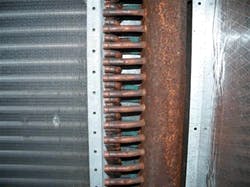Ultraviolet Devices Helps Hospital Patients Breathe Easier
Hospital patients have enough on their mind without being concerned about the air they breathe containing dangerous microorganisms. But that's exactly what can happen in the sealed environment of today's modern buildings, such as hospitals. HVAC systems recycle and spread the air sick patients breathe throughout the building. They can also contribute to the problem by becoming a breeding ground for molds and pathogens that thrive in the dark and moist environment of the system's coils and drip pans. Hoping to reduce these dangerous airborne contaminants is exactly what St. Michaels Hospital in Stevens Point, WI, had in mind when it decided to retrofit an air-handling unit from UltraViolet Devices Inc. (UVDI).
St. Michaels had an ongoing problem in the neonatal section of the hospital. Musty orders in this area raised concerns that mold and other microorganisms might lead to respiratory problems in vulnerable infants. To combat this condition carbon filters were installed, but the problem persisted. "That's when they decided to give UVDI's ultraviolet light a chance," says Mike Perinovic, owner of Filtration Concepts Inc. "We installed a custom-designed system, and in just a matter of months the odors were gone. They were so happy with the results that they are contracting with us to do further installations."
Brian Schulist, plant operations supervisor at St. Michaels Hospital, says that there are surprising improvements in their HVAC system after only a few months of use. "The musty smell has disappeared, the coil fins and diffuser plate have begun to shine, the copper tubes went from green to a copper color. The pleated filters that would normally start to darken are still looking clean. We have washed our other air-handler coils and will be able to skip this unit this year."
Why Ultraviolet Light for HVAC?
The use of ultraviolet light to kill microorganisms is not a new concept; it was first used for this purpose in the early 1900s. Later discoveries found that ultraviolet light in the C bandwidth (UVC) could be effective at killing pathogens in the air ducts of HVAC systems. The problem was deciding how much light is needed for the given amount of time the surface or air stream is exposed.
UVDI has developed computer-modeling software that evaluates each individual system and designs a solution that is specific to that application. This allows them to create a plan that will clean any surface of harmful microorganisms without having to use the higher intensity UVC lights that other systems resort to. This can create significant savings at the time of installation as well as when it becomes necessary to replace the UVC lights.
"With our software we can design a system that is exactly matched to our customer's needs," says UVDI Senior Product Marketing Manager Larry Randall. "By not over-building their system we can still get the job done and pass the savings on to our customers."
In addition to the upfront savings a UVDI system provides, customers also will recognize further savings in the form of lower maintenance costs. The use of UVC light inside the air-handling units of an HVAC system stops the growth of organisms on cooling coils, increasing the systems efficiency and reducing the need for cleaning. This in turn means both lower operating and maintenance costs and cuts down on the amount of worker exposure to these dangerous organisms and the chemicals used during system cleaning.
"The primary reason for installing an ultraviolet system is because it has been demonstrated to improve IAQ in these public institutions," says UVDI's Randall. "But clients will also recognize significant savings in the form of reduced maintenance cost and energy savings through improved efficiency from their HVAC system. The coils exposed to the UVC light are cleaned and remain clean. This reduces static pressure, increases heat transfer and CFM, and makes them more efficient."
About UVDI
Founded in 1949 by Luis Veloz, an engineer at Westinghouse, the company's first products focused on water disinfection and air purification using ultraviolet (UV) technology. The first products were simple but very effective and were initially sold to the U.S. Department of Agriculture. Today, Valencia, CA-based UVDI continues to drive innovations in UV technology for the treatment of air, surfaces, and water and has built one of the world's most dedicated and comprehensive research, development, and engineering teams in the world. For more information about UV technology and UVDI, please visit www.altruv.com and www.uvdi.com or call (800) PUREUV.
